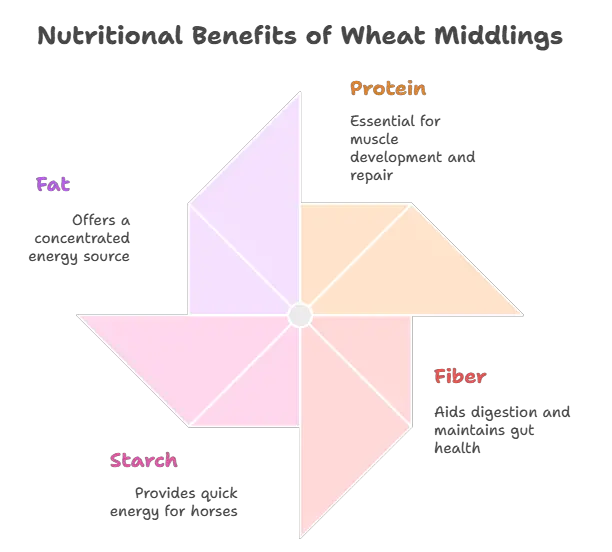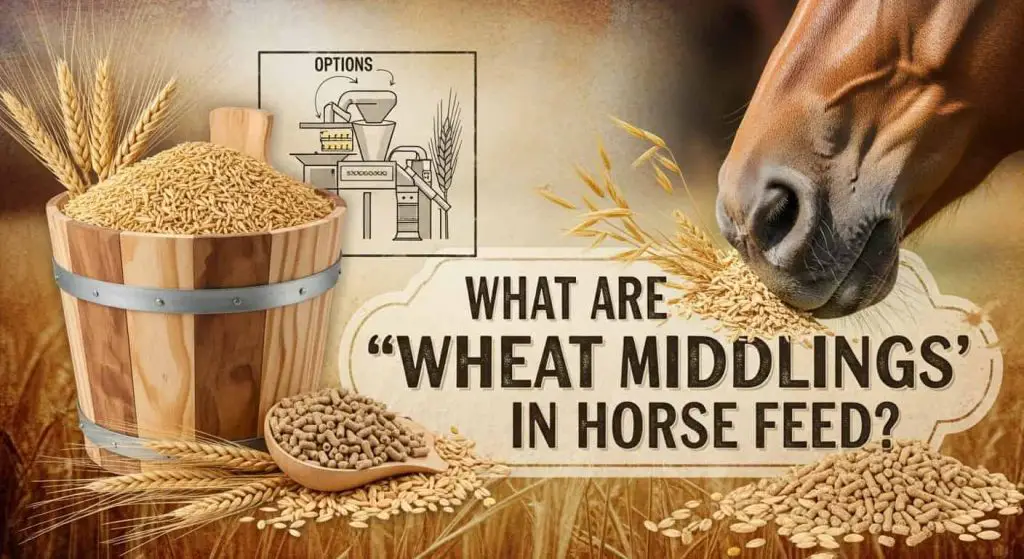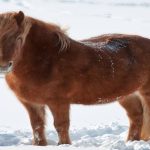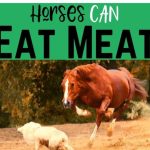Are you curious about what goes into your horse’s feed? If you’re like most horse owners, you want the best nutrition for your equine friend.
One ingredient you might have come across is “wheat middlings. ” But what exactly are wheat middlings, and why are they in horse feed? Understanding the components of your horse’s diet can feel like solving a puzzle. However, knowing more about wheat middlings can help you make informed decisions that benefit your horse’s health and performance.
We’ll demystify wheat middlings, explaining their nutritional value and why they could be a key part of your horse’s diet. Get ready to discover how this ingredient might just be the secret to optimal equine health.
Wheat Middlings Defined
Wheat middlings, a byproduct of wheat flour production, serve as a nutritious ingredient in horse feed. These fine particles offer essential nutrients like protein and fiber, supporting horse health. Ideal for energy, wheat middlings help maintain a balanced diet for horses.

Wheat middlings are a common ingredient in horse feed. They come from the wheat milling process. This process separates the wheat kernel into flour and by-products. Wheat middlings are the by-products. They are rich in fiber, protein, and energy. These nutrients are essential for a horse’s diet. Horse owners often choose wheat middlings for their nutritional benefits. They are cost-effective and versatile. They can be mixed with other feed ingredients easily. This makes them a popular choice in horse nutrition.
Components Of Wheat Middlings
Wheat middlings contain several key components. They include protein, fiber, starch, and fat. Each component plays a role in a horse’s diet. Protein is crucial for muscle development and repair. Fiber aids digestion and maintains gut health. Starch provides quick energy. Fat offers a concentrated energy source. These elements make wheat middlings a balanced feed option.
Processing Methods
Processing wheat middlings involves several steps. The wheat kernel is first ground. This separates the flour from the by-products. The by-products are then sifted. This process removes any unwanted materials. The final product is wheat middlings. They are then packaged for distribution. This ensures they remain clean and safe for horses. Different mills may use varying methods. Yet, the goal remains the same. To produce a high-quality feed ingredient. `

Credit: www.afia.org
Nutritional Profile
Wheat middlings might sound like something out of a medieval recipe, but they play a modern-day role in horse feed. Understanding the nutritional profile of these middlings can help you make informed choices for your horse’s diet. You might wonder, what makes wheat middlings a valuable part of horse feed? Let’s break down their nutritional elements to find out.
Protein Content
Protein is an essential nutrient for horses, supporting muscle development and repair. Wheat middlings contain a moderate amount of protein, typically ranging from 15% to 18%. This level can help meet your horse’s daily needs, especially if they are active or recovering from an injury. Think of the protein in wheat middlings as a reliable source to complement the primary protein in your horse’s diet.
Fiber Benefits
Fiber is crucial for a horse’s digestive health. Wheat middlings offer a good amount of dietary fiber, which helps keep things moving smoothly in the gut. If you’ve ever dealt with a horse with digestive issues, you know how important fiber is. By including wheat middlings, you provide a supportive component to maintain a healthy digestive system and prevent colic.
Minerals And Vitamins
Wheat middlings also contain valuable minerals and vitamins. They offer phosphorus, an important mineral for bone health, and some B vitamins, which support energy production. However, they aren’t a complete source of vitamins and minerals. Consider them a beneficial addition to a well-rounded diet. You may want to balance them with other feeds to ensure your horse gets everything it needs.
In your quest for the perfect horse diet, have you considered how each ingredient contributes to your horse’s wellbeing? Wheat middlings can be a useful part of the mix, offering protein, fiber, and essential nutrients. What other feed components do you rely on to keep your horse healthy and thriving?
Benefits For Horses
Wheat middlings in horse feed provide essential nutrients, including fiber and protein. They support digestive health and energy. This ingredient can be beneficial for maintaining a balanced diet for horses.
Wheat middlings, often referred to as “wheat mids,” are a valuable component in horse feed, offering a variety of benefits for your equine companions. These by-products of the wheat milling process are often misunderstood but hold significant nutritional value. Including wheat middlings in your horse’s diet can provide them with essential nutrients, energy, and support for overall health.
Energy Source
Wheat middlings are a fantastic energy source for horses. They contain a moderate level of starch, providing quick energy that can benefit active or working horses. If your horse needs a bit more pep in its step, wheat middlings might be the answer. A friend of mine noticed her competition horse lacked energy during events. Adding a feed with wheat middlings made a noticeable difference in his performance. Could your horse benefit from a similar energy boost?
Digestive Health
Maintaining digestive health is crucial for any horse, and wheat middlings play a role here too. They are high in fiber, which aids in digestion and promotes a healthy gut. Horses require a balanced diet, and fiber is a key component of that balance. Feeding your horse wheat middlings can help ensure they have adequate fiber intake. This can be especially helpful if your horse is prone to digestive issues. Have you considered the fiber content in your horse’s current diet?
Weight Management
Weight management is another area where wheat middlings can be beneficial. Their nutrient-rich composition helps horses maintain a healthy weight without adding excess calories. This makes them a suitable option for horses that are prone to gaining weight easily. A stable owner I know had a horse that was quickly gaining weight. Switching to a feed with wheat middlings helped manage the horse’s weight effectively. Could this be a solution for your horse’s weight management needs? Incorporating wheat middlings into your horse’s feed can provide practical benefits, whether it’s boosting energy, supporting digestion, or managing weight. Understanding these advantages can help you make informed decisions about your horse’s diet. What are the specific needs of your horse, and how might wheat middlings fit into their nutritional plan?

Credit: madbarn.com
Incorporation In Feed
Wheat middlings in horse feed offer fiber, protein, and energy. They are by-products from milling wheat into flour. These nutritious components support digestion and overall health in horses.
Incorporating wheat middlings into horse feed can be a game-changer for improving your horse’s nutrition. These nutrient-rich by-products from milling wheat are packed with fiber, protein, and essential minerals. They are an excellent addition to a horse’s diet, especially when you know how to blend them effectively with other ingredients.
Blending With Other Ingredients
You might wonder how to mix wheat middlings into your horse’s feed. The good news is they blend well with grains like oats and barley, offering a balanced diet. Mixing them with other fibers like beet pulp can enhance digestion and add variety to your horse’s meals. Sometimes, I’ve found combining wheat middlings with molasses creates a tasty treat that my horse absolutely adores. This can be a great way to encourage picky eaters.
Recommended Ratios
Determining the right ratio is crucial. Generally, wheat middlings should make up about 10-20% of the total feed. This ratio ensures your horse gets the benefits without overloading on protein. It’s important to consider your horse’s individual needs—age, activity level, and health status all play a part. Have you ever noticed your horse’s energy levels after adjusting their feed? A slight tweak in these ratios can make a noticeable difference in their performance and well-being. While experimenting, always consult with a nutritionist to tailor the best diet for your horse. You’ll be surprised at how small changes can boost their vitality.
Considerations And Precautions
Understanding wheat middlings is crucial for horse feed safety. These by-products of wheat milling provide fiber and energy. Monitor your horse’s diet for balance, ensuring it meets nutritional needs without overloading on carbohydrates.
When you think about what you feed your horse, you want to ensure that every ingredient is safe and beneficial. Wheat middlings can be a valuable addition, but it’s crucial to consider potential risks and take necessary precautions. Understanding these considerations can help you make informed decisions about your horse’s diet.
Allergies And Sensitivities
Horses, like humans, can have allergies or sensitivities to certain foods. Wheat middlings, although nutritious, may trigger reactions in some horses. If your horse has shown signs of allergies in the past, it’s wise to monitor them closely when introducing wheat middlings. Pay attention to changes in behavior or health. Look for symptoms like hives, respiratory issues, or digestive disturbances. If you notice anything unusual, consult your veterinarian immediately. It’s better to be cautious than sorry.
Quality And Purity
The quality and purity of wheat middlings are essential for your horse’s health. Always check the source and processing methods. Are you buying from a reputable supplier? Ensure the product is free from contaminants and additives. Inspect packaging and labels carefully. Look for certifications or quality assurances. Buying from trusted brands can minimize the risk of impurities. Remember, what you feed your horse affects their well-being directly. Consider how the wheat middlings are stored. Improper storage can lead to mold or spoilage. Keeping the feed in a cool, dry place can prevent these issues. Your diligence in ensuring quality can make a significant difference. Is your horse’s diet balanced? Wheat middlings should complement other nutritional components, not replace them. Consult a nutritionist to tailor a diet that meets your horse’s specific needs. Your careful planning can contribute to your horse’s optimal health.
Comparing Wheat Middlings To Other Feed Components
Wheat middlings offer a nutritious option in horse feed, balancing fiber and protein content. These by-products of wheat milling provide energy while remaining cost-effective. Their versatility in horse diets makes them a valuable component compared to other feed ingredients.
Understanding the role of wheat middlings in horse feed is crucial for making the right dietary choices for your equine friends. A staple in many horse feeds, wheat middlings offer a range of nutritional benefits. But how do they stack up against other common feed components? Let’s dive into some comparisons that might just influence your next feed purchase.
Bran Vs. Middlings
Bran and middlings are often confused, but they serve different nutritional purposes. Bran is the outer layer of the wheat kernel and is high in fiber. This can help keep a horse’s digestive system running smoothly. Middlings, however, contain parts of the wheat kernel that are richer in protein and energy. This makes them an excellent choice if you’re looking to boost your horse’s calorie intake without adding too much bulk to the feed. Imagine you’re trying to decide between adding bran or middlings to your horse’s diet. If you’re aiming for a high-fiber diet, bran is your go-to. But for a protein-rich, energy-boosting option, middlings should be your choice.
Middlings Vs. Whole Grains
Whole grains like oats and barley are a traditional choice in horse feed. They are unprocessed and retain all parts of the grain, offering a complete nutrient profile. However, they can be harder for some horses to digest, especially those with sensitive stomachs. In contrast, wheat middlings are a byproduct of flour milling and are partially processed. This makes them easier to digest, which can be a game-changer for older horses or those with specific dietary needs. Have you ever noticed your horse struggling with whole grains? Perhaps it’s time to consider middlings. They provide a balanced source of energy without overwhelming the digestive system. Incorporating different feed components requires a clear understanding of your horse’s needs. Think about what you aim to achieve with your feed. Is it more energy, better digestion, or a blend of both? Each feed component has its unique benefits, and knowing these can transform your horse’s diet for the better.
Market And Availability
Wheat middlings are a common component in horse feed. They are nutritious and provide energy for horses. The market for wheat middlings is growing due to their benefits. Availability varies based on location and supplier. Understanding the market can help in making informed choices.
Supplier Options
There are many suppliers of wheat middlings. Some focus only on animal feed. Others offer a wide range of feed products. Local feed stores often stock wheat middlings. Online suppliers provide convenient options for purchase. It’s important to choose a reliable supplier.
Cost Factors
The cost of wheat middlings can vary. Prices depend on quality and location. Bulk purchases may offer discounts. Seasonal factors can affect pricing. Transportation costs might impact the final price. Comparing suppliers can help find the best deal.

Credit: thehorse.com
Frequently Asked Questions
What Are Wheat Middlings In Horse Feed?
Wheat middlings are a by-product of milling wheat into flour. They are nutrient-rich, offering fiber, protein, and energy. Horse feed often includes wheat middlings to enhance nutritional content. This ingredient helps maintain healthy digestion and energy levels in horses.
Are Wheat Middlings Safe For Horses?
Yes, wheat middlings are safe for horses when included in balanced diets. They provide essential nutrients without adverse effects. However, it’s crucial to ensure they are part of a well-formulated feed to avoid nutritional imbalances.
How Do Wheat Middlings Benefit Horses?
Wheat middlings benefit horses by providing fiber and energy. They support digestive health and aid in maintaining weight. Additionally, they offer protein, which is essential for muscle development and overall health.
Can Wheat Middlings Cause Allergies In Horses?
Wheat middlings rarely cause allergies in horses. Most horses tolerate them well as part of a balanced diet. However, if a horse shows signs of allergies, consult a veterinarian for advice.
Conclusion
Wheat middlings offer valuable nutrients for horses. They enhance energy levels and support healthy digestion. Balanced diets are crucial for horse well-being. Including wheat middlings ensures horses receive essential fiber and protein. It’s important to consult with veterinarians when adjusting feed.
Every horse has unique nutritional needs. Proper feeding helps maintain optimal health. Owners should monitor horse responses to new diets. Understanding feed components improves care decisions. Wheat middlings can be a beneficial addition. Always aim for a balanced, nutrient-rich diet.
Your horse deserves the best nourishment. Happy and healthy horses thrive with thoughtful feeding choices.






